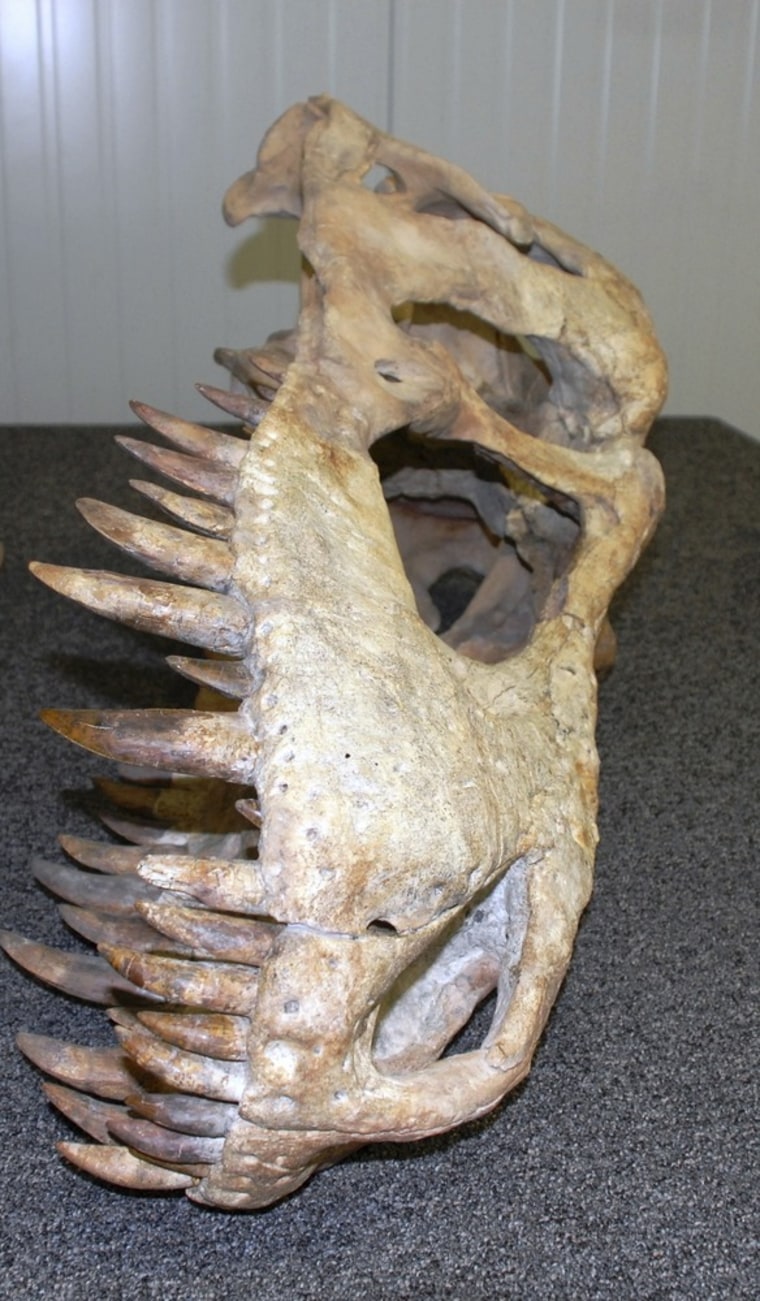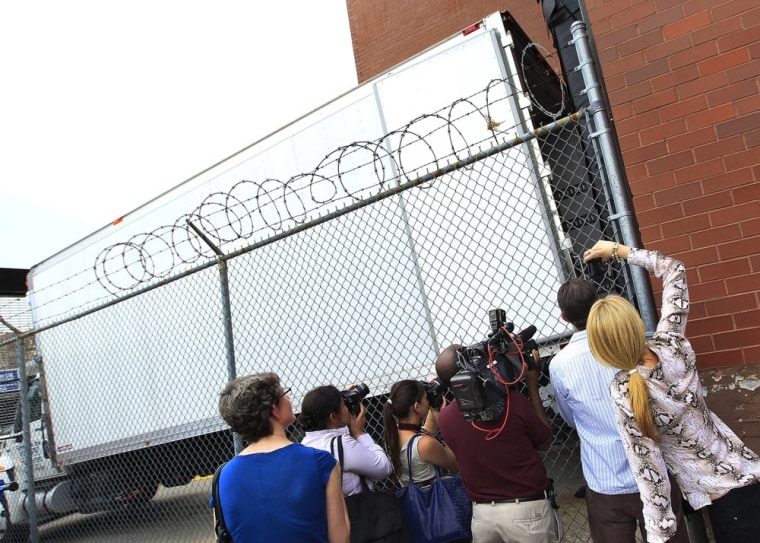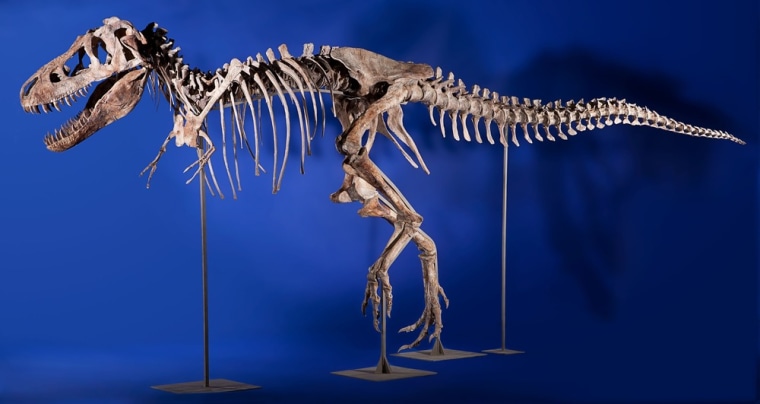The U.S. government seized a rare dinosaur skeleton Friday, in what observers for the Mongolian government and a dinosaur expert called an important step toward returning the skeleton to its home in Mongolia.
Wooden crates holding pieces of the Tyrannosaurus bataar fossil were loaded onto a white truck at a Queens storage center shortly before it was driven away to a facility whose location was not disclosed.
"We are one step closer to bringing this rare Tyrannosaurus bataar skeleton back home to the people of Mongolia," Mongolian President Elbegdorj Tsakhia said in a statement handed out by his Houston lawyer, Robert Painter, who took photographs of the seizure through a chain-link fence outside the Cadogan Tate Fine Art property where it had been stored.
"Today we send a message to looters all over the world: We will not turn a blind eye to the marketplace of looted fossils," he said.
Bolortsetseg Minjin, director of the Institute for the Study of Mongolian Dinosaurs, took pictures of the exchange as well, saying: "It's a very exciting event. It's just unbelievable. I never expected it would be this fast."
The seizure was ordered by a federal judge in Manhattan earlier this week after the United States requested it in a lawsuit, saying the relics had been brought into the country with documents that disguised the potentially valuable dinosaur skeleton that originated in Mongolia as reptile bones from Great Britain.
Seller defends his actions
Eric Prokopi, 37, of Gainesville, Florida, defended his handling of the skeleton in a statement Thursday, saying that he was not an international bone smuggler and that he had worked since bringing the bones into the country in March 2010 to turn chunks of rocks and broken bones "into an impressive skeleton" that he came to call "Ty."
"I can wholeheartedly say the import documents are not fraudulent, a truth I am confident will be brought to light in the coming weeks," he said. "The value was declared much lower than the auction value because, quite simply, it was loose, mostly broken bones and rocks with embedded bones. It was not what you see today, a virtually complete, mounted skeleton."

The bones were valued on import documents at only $15,000, but the skeleton Prokopi put together sold at auction last month for $1.052 million, contingent on the outcome of litigation involving the dinosaur.
Although the buyer has not been disclosed, Painter said he had been told that a New York private gallery owner had made the winning bid.
Prokopi responded to an email request for comment Friday by writing: "My reaction to the government driving away with my dinosaur in a large white truck is the reaction I imagine Indiana Jones had to the ark being put into storage at the end of his film."
Held in 'secure location'
After the seizure Friday, Glenn Sorge, a deputy special agent in charge of Homeland Security Investigations for the Department of Homeland Security in New York, said the dinosaur "is now in the custody of the U.S. government and will be stored in a secure location."
The dinosaur was taken from the custody of Heritage Auctions, a Dallas-based company. Its co-chairman, Jim Halperin, said Friday that the company will continue to work with Prokopi.
"We hope arrangements can be made for the public to view it as a museum or other convenient venue while our efforts continue to reach a fair and just resolution for our consignor, who had spent a year of his life and considerable expense identifying, restoring, mounting and preparing what had previously been a much less valuable matrix of unassembled, underlying bones and bone fragments," he said.
The Tyrannosaurus bataar, also known as a Tarbosaurus bataar, lived during the late Cretaceous period, approximately 70 million years ago, the government said in its lawsuit. It was first discovered in 1946 during a joint Soviet-Mongolian expedition to the Gobi Desert in the Mongolian Omnogovi Province. Mongolia has enacted laws since 1924 declaring dinosaur fossils to be the property of the government of Mongolia and criminalizing their export from the country.

Claims and counterclaims
Mark Norell, head paleontologist with New York's American Museum of Natural History, was not at the seizure but said in a telephone interview that he was one of several people to spread word about the dinosaur's planned sale at auction. He challenged Prokopi's claim that the skeleton may have come from outside Mongolia, saying that some fragments of the same species of dinosaur had been found in adjacent China, but no complete skeletons. He noted also that China's laws regarding excavation were stricter than Mongolia's.
He said Prokopi was inaccurate when he claimed the skeleton was professionally excavated and had lost some claws and teeth due to the weather, and that some teeth had slipped out before burial.
"That's just not the case," he said. "I've excavated fossils my entire adult career. Teeth and claws are about the last things to erode because they're so hard," he said.
Minjin said the skeleton was one of only 10 to 15 full skeletons of the Tyrannosaurus bataar to exist worldwide.
"Finding this kind of complete skeleton is very rare, very special," she said.
Fredrik T. Hiebert, an archaeologist with National Geographic mission programs who attended the seizure, said the likelihood that the dinosaur will end up in Mongolia was vital to the country bordered by China and Russia.
"This is a bigger story than just a dinosaur. It's part of the cultural identity of Mongolia," he said, noting that the nation was re-establishing its identity after decades of Soviet control that ended just over two decades ago.
Still, he said there was no denying the dinosaur had gained a measure of fame. "It's become a rock star, pardon the pun."
